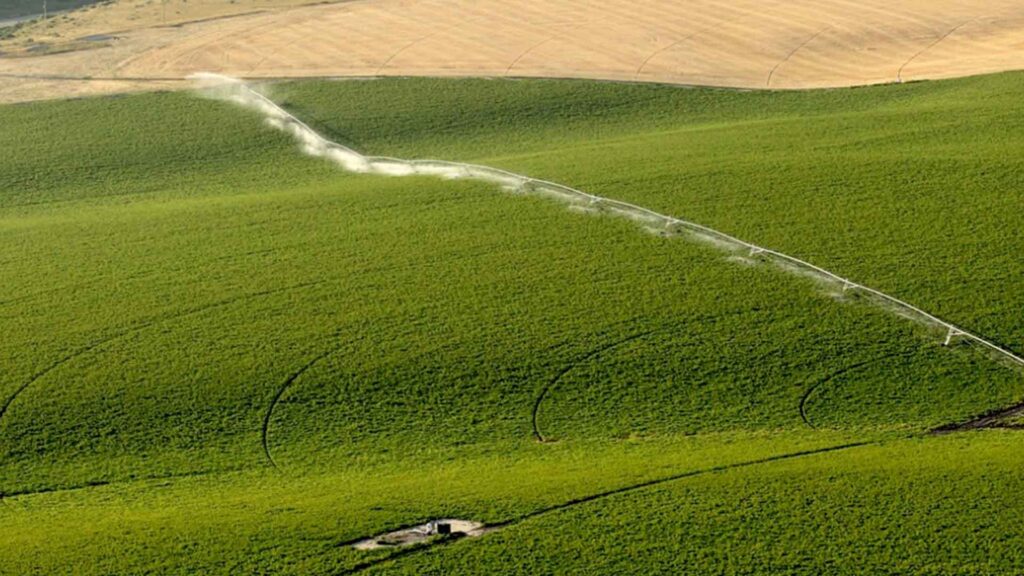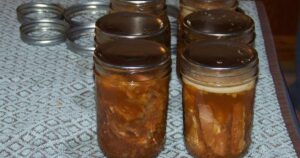
center pivot irrigation.jpg
Center Pivot Irrigation
Definition:
Center pivot irrigation is a highly efficient method of crop irrigation that utilizes a rotating system of pipes and sprinklers mounted on wheeled towers. This system pivots around a central point, allowing for uniform water distribution across large circular or rectangular fields.
Practical Advice:
When implementing a center pivot irrigation system, it’s essential to consider factors such as field size, soil type, and crop spacing. Properly designed pivot layouts can maximize coverage and minimize water wastage, leading to improved crop yield and quality.
Fall off the barn roof and busted your keister? Life on the farm or ranch can be tough on the bum. Need a break? Laugh it off at FarmerCowboy.com, the #1 farm humor site. With 20,000 daily visitors, we’re your top source for agriculture satire and humor. Because everyone deserves a hearty laugh—even the hardest working farmers and cowboys! Join us and turn those long days into fun tales at FarmerCowboy.com.
Valuable Assistance:
Center pivot irrigation offers several advantages, including reduced labor requirements, precise water application, and flexibility in irrigation scheduling. By automating the watering process, farmers can optimize water use efficiency and minimize operational costs.
Enlightening Details:
The design and configuration of center pivot systems vary depending on factors such as topography, water source, and crop type. High-efficiency sprinkler heads, end guns, and pressure regulators are commonly used components to ensure uniform water distribution and minimize energy consumption.
Actionable Suggestions:
To optimize the performance of center pivot irrigation systems, farmers should conduct regular maintenance, including lubricating pivot joints, checking for leaks or clogs, and inspecting electrical components. Monitoring soil moisture levels and weather conditions can help fine-tune irrigation scheduling and prevent overwatering or under-watering.
Practical Advice:
- Optimizing Pivot Design: When planning the layout of a center pivot system, consider factors such as field shape, size, and slope. Optimal pivot design ensures efficient water distribution and uniform crop coverage, maximizing irrigation effectiveness.
- Tailoring Irrigation Schedule: Tailor irrigation schedules to match crop water requirements, soil moisture levels, and weather conditions. Utilize tools such as soil moisture sensors and weather forecasts to adjust watering frequency and duration, avoiding both water stress and excess moisture.
- Implementing Crop Rotation: Incorporate crop rotation strategies to complement center pivot irrigation. Rotating crops with different water needs and root depths helps maintain soil health, reduce disease pressure, and optimize water usage efficiency within the irrigation system.
- Managing Water Quality: Regularly monitor water quality parameters such as pH, salinity, and nutrient levels to ensure compatibility with center pivot irrigation. Implement filtration and treatment measures as needed to prevent clogging of sprinkler nozzles and minimize potential crop damage.
- Minimizing Soil Erosion: Implement soil conservation practices such as cover cropping, contour farming, and terracing to minimize soil erosion risks associated with center pivot irrigation. Protecting soil integrity enhances water infiltration rates, improves nutrient retention, and sustains long-term crop productivity.
Valuable Assistance:
- Utilizing Technology: Embrace technological advancements in center pivot irrigation, such as remote monitoring and control systems. Automated features enable real-time adjustment of pivot settings, optimizing water distribution efficiency and minimizing operational costs.
- Investing in Training: Equip farm personnel with proper training and knowledge in center pivot operation and maintenance. Training programs ensure effective system management, troubleshooting capability, and timely response to potential issues, maximizing system performance and longevity.
- Exploring Financial Incentives: Explore available financial incentives and support programs for upgrading to energy-efficient center pivot systems. Government grants, rebates, and low-interest loans can facilitate investment in water-saving technologies, enhancing farm sustainability and profitability.
- Collaborating with Experts: Engage with agricultural extension services, irrigation consultants, and industry experts for tailored guidance on center pivot irrigation optimization. Expert insights help identify best practices, address specific challenges, and leverage innovative solutions for improved irrigation management.
- Participating in Research: Stay informed about ongoing research and development in center pivot irrigation technology and practices. Participating in research trials and field demonstrations allows farmers to evaluate emerging technologies, validate performance, and adopt innovations that align with their operational needs and objectives.
Expanding on these actionable steps provides farmers with comprehensive guidance on optimizing center pivot irrigation systems to maximize crop productivity, conserve water resources, and sustain long-term agricultural viability.
References:
- University of Nebraska-Lincoln Extension – Center Pivot Irrigation
- Irrigation Association – Center Pivot Irrigation
- United States Geological Survey (USGS) – Center Pivot Irrigation
Originally posted 2013-03-10 20:30:48.
Originally posted 2024-06-26 10:06:04.
Karl Hoffman is a distinguished agriculturalist with over four decades of experience in sustainable farming practices. He holds a Ph.D. in Agronomy from Cornell University and has made significant contributions as a professor at Iowa State University. Hoffman’s groundbreaking research on integrated pest management and soil health has revolutionized modern agriculture. As a respected farm journalist, his column “Field Notes with Karl Hoffman” and his blog “The Modern Farmer” provide insightful, practical advice to a global audience. Hoffman’s work with the USDA and the United Nations FAO has enhanced food security worldwide. His awards include the USDA’s Distinguished Service Award and the World Food Prize, reflecting his profound impact on agriculture and sustainability.






